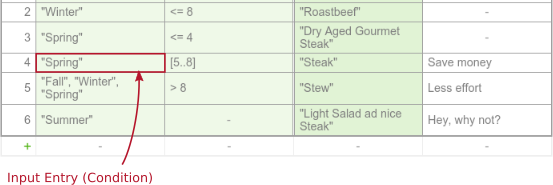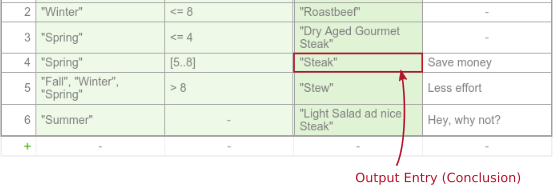DMN Decision Table Rule

A decision table can have one or more rules. Each rule contains input and output entries. The input entries are the condition and the output entries the conclusion of the rule. If each input entry (condition) is satisfied, then the rule is satisfied and the decision result contains the output entries (conclusion) of this rule.
A rule is represented by a rule element inside a decisionTable XML element.
<?xml version="1.0" encoding="UTF-8"?>
<definitions xmlns="http://www.omg.org/spec/DMN/20151101/dmn.xsd" id="definitions" name="definitions" namespace="http://camunda.org/schema/1.0/dmn">
<decision id="dish" name="Dish">
<decisionTable id="decisionTable">
<!-- ... -->
<rule id="rule2-950612891-2">
<inputEntry id="inputEntry21">
<text>"Winter"</text>
</inputEntry>
<inputEntry id="inputEntry22">
<text><![CDATA[<= 8]]></text>
</inputEntry>
<outputEntry id="outputEntry2">
<text>"Roastbeef"</text>
</outputEntry>
</rule>
<!-- ... -->
</decisionTable>
</decision>
</definitions>
Input Entry (Condition)

A rule can have one or more input entries, which are the conditions of the rule.
Each input entry contains an expression in a text element as child of an
inputEntry XML element.
The input entry is satisfied when the evaluated expression returns true.
<inputEntry id="inputEntry41">
<text>"Spring"</text>
</inputEntry>
Empty Input Entry
In case an input entry is irrelevant for a rule, the expression is empty, which is always satisfied.
<inputEntry id="inputEntry41">
<text/>
</inputEntry>
If FEEL is used as expression language, then an empty input entry is represented
by a -. Otherwise, the expression is empty.
Expression Language of an Input Entry
The expression language of the input entry can be specified by the
expressionLanguage attribute on the inputEntry XML element. The supported
expression languages are listed in the User Guide.
<inputEntry id="inputEntry41"
expressionLanguage="juel">
<text>cellInput == "Spring"</text>
</inputEntry>
If no expression language is set then the global expression
language, which is set on the definitions XML element, is used.
<definitions id="definitions"
name="definitions"
xmlns="http://www.omg.org/spec/DMN/20151101/dmn.xsd"
expressionLanguage="groovy"
namespace="http://camunda.org/schema/1.0/dmn">
<!-- ... -->
</definitions>
In case no global expression language is set, the default expression language is used instead. The default expression language for input entries is FEEL. Please refer to the User Guide to read more about expression languages.
Output Entry (Conclusion)

A rule can have one or more output entries, which are the conclusions of the
rule. Each output entry contains an expression in a text element as child of
an outputEntry XML element.
<outputEntry id="outputEntry4">
<text>"Steak"</text>
</outputEntry>
Empty Output Entry
If the output entry is empty, then the output is ignored and not part of the decision table result.
<outputEntry id="outputEntry4">
<text/>
</outputEntry>
Expression Language of an Output Entry
The expression language of the expression can be specified by the
expressionLanguage attribute on the outputEntry XML element. The supported
expression languages are listed in the User Guide.
<outputEntry id="outputEntry4"
expressionLanguage="groovy">
<text>"Steak"</text>
</outputEntry>
If no expression language is set then the global expression
language, which is set on the definitions XML element, is used.
<definitions id="definitions"
name="definitions"
xmlns="http://www.omg.org/spec/DMN/20151101/dmn.xsd"
expressionLanguage="groovy"
namespace="http://camunda.org/schema/1.0/dmn">
<!-- ... -->
</definitions>
In case no global expression language is set, the default expression language is used instead. The default expression language for output entries is JUEL. Please refer to the User Guide to read more about expression languages.
Description

A rule can be annotated with a description that provides additional
information. The description text is set inside the description XML element.
<rule id="rule4">
<description>Save money</description>
<!-- ... -->
</rule>